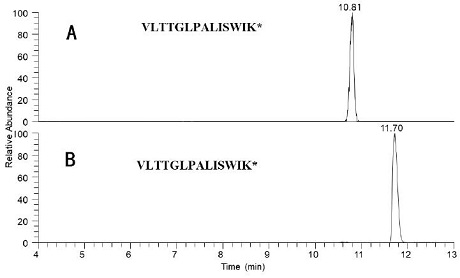Method for quantitatively detecting melittin by liquid chromatography-tandem mass spectrometry
A technology of liquid chromatography and tandem mass spectrometry, which is applied in the direction of measuring devices, instruments, scientific instruments, etc., can solve the problems of difficult to achieve accurate quantification of melittin and complex matrix, and achieve good accuracy and precision, strong specificity, The effect of high sensitivity
- Summary
- Abstract
- Description
- Claims
- Application Information
AI Technical Summary
Problems solved by technology
Method used
Image
Examples
Embodiment 1
[0048] Example 1 Method for Determination of Melittin Content in Bee Venom by Liquid Chromatography Tandem Mass Spectrometry
[0049] 1. Sample source
[0050] A total of more than 140 samples of real bee venom were purchased from the market or beekeepers.
[0051] 2. Experimental procedure
[0052] 2.1 Solution preparation
[0053] 100 mM DTT: Weigh 308.5 mg DTT, 40 mM NH 4 HCO 3 Dilute the solution to 20 mL, dispense 1 mL into each tube, and store in a -20°C refrigerator until use.
[0054] 40 mM NH 4 HCO 3 Solution: weigh 0.316 g NH 4 HCO 3 , dilute to 100 mL with ultrapure water, and store in a 4°C refrigerator until use.
[0055] 100 mM IAA solution: Weigh 0.39 g of IAA, add 40 mM NH 4 HCO 3 The solution was adjusted to 20 mL and stored in a -20°C refrigerator until use.
[0056] Activation solution: 500 μL ACN, 3 μL TFA, dilute to 1 mL with ultrapure water, store at 4°C.
[0057] Equilibrium solution: 1 μL TFA, dilute to 1 mL with ultrapure water, store at 4...
Embodiment 2
[0079] Embodiment 2 compares with existing melittin detection method
[0080] 1. Sample source
[0081] Purchase more than 140 samples of real bee venom from the market or beekeepers.
[0082] 2. Experimental steps
[0083] (1) Solution preparation
[0084] With embodiment 1.
[0085] (2) Pretreatment of bee venom samples
[0086] ① Accurately weigh 1 g of the bee venom to be tested evenly into a 10 mL centrifuge tube, add 1 mL of deionized water, and vortex until the bee venom is fully dissolved. Centrifuge at 14000 rpm for 12 min at 4 °C. Collect the supernatant in a new 2 mL centrifuge tube. This supernatant solution can be used as undigested bee venom solution for analysis, and can also be used as protein solution for the next enzyme digestion reaction.
[0087] ② Pipette 200 μL of protein solution and 800 μL of 40 mM NH 4 HCO 3 mix. Add 100 μL of 30 mM DTT solution to the above mixed solution, react at room temperature for 60 min, and then add 500 μL of 100 mM IAA...
Embodiment 3
[0095] Example 3 Quantitative detection of melittin in bee venom products
[0096] 1. Sample source
[0097] Buy products marked with "bee venom" from the market, including toothpaste (10 parts), facial mask (25 parts), plaster (5 parts) and a total of 40 products.
[0098] 2. Experimental steps
[0099] (1) Solution preparation
[0100] With embodiment 1.
[0101] (2) Pretreatment of bee venom samples
[0102] ① Accurately weigh 1 g of the bee venom product to be tested evenly into a 10 mL centrifuge tube, add 1 mL of deionized water, and vortex until the bee venom product is fully dissolved. Centrifuge at 14000 rpm for 12 min at 4 °C. Collect the supernatant in a new 2 mL centrifuge tube.
[0103] ② Pipette 200 μL of protein solution and 800 μL of 40 mM NH 4 HCO 3 mix. Add 100 μL of 30 mM DTT solution to the above mixed solution, react at room temperature for 60 min, and then add 500 μL of 100 mM IAA solution and react in dark at room temperature for 60 min.
[010...
PUM
 Login to View More
Login to View More Abstract
Description
Claims
Application Information
 Login to View More
Login to View More - R&D
- Intellectual Property
- Life Sciences
- Materials
- Tech Scout
- Unparalleled Data Quality
- Higher Quality Content
- 60% Fewer Hallucinations
Browse by: Latest US Patents, China's latest patents, Technical Efficacy Thesaurus, Application Domain, Technology Topic, Popular Technical Reports.
© 2025 PatSnap. All rights reserved.Legal|Privacy policy|Modern Slavery Act Transparency Statement|Sitemap|About US| Contact US: help@patsnap.com



